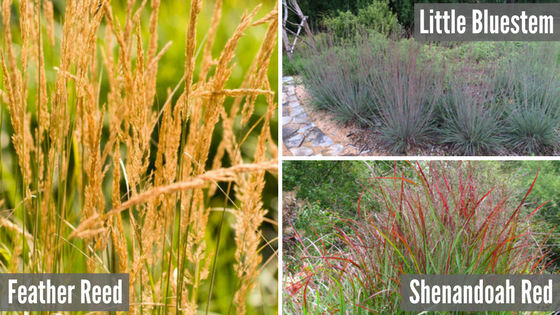An Ode to Ornamental Grass

Beyond the excitement surrounding the holidays, the onset of winter can leave folks feeling a bit lackluster at times. The vibrant colors of summer and fall have faded away. The trees have shed their leaves, leaving them bare and dormant. It seems like everything in nature has settled into varying shades of gray. Landscapers are optimists, if nothing else, always seeking to find beauty in our surroundings. Considering all this, it’s the perfect time to pay homage to one of the shining stars of the winter landscape: ornamental grasses!
What’s so great about ornamental grass?
Ornamental grasses are low maintenance. These grasses need very little care overall. Once a year in early spring before new growth emerges, they need to be cut back to about 6” from the ground, depending on the size of the grass. Once they’re established, some grasses require little extra water, depending on the variety. Like all new plantings, they do require watering to get them established. Ornamental grasses also benefit from being seasonally fertilized, but it’s not required.
Ornamental grasses provide seasonal interest. The visual and textural characteristics of ornamental grass make them a great addition to residential and commercial landscapes. Depending on the variety, these grasses are vibrant variations of green in the spring and transition into warmer tones of orange, red, and tan when fall arrives. Barren winter landscapes can be transformed by incorporating these plants of varying height, tone, and texture.
Ornamental grasses are practical, too! Beyond the aesthetic appeals of grasses in your landscape, the height of some ornamental grasses makes them ideal as a natural screen to improve privacy. The sound of the grass rustling in the wind can also help block out unwanted sources of noise pollution.
A few favorites from the mouths of landscape designers

We asked Kathryn and Donna, two of our beloved landscape designers, to tell us about a few of their favorite ornamental grasses. Here’s what they said!
“The Blues” Little Bluestem Grass – Kathryn and Donna agree this is a must-have. This grass stays small, approximately 2-ft tall and wide. It has blue-green foliage that turns orange-red during the fall. Little Bluestem Grass works great for mass plantings and looks stunning in a native landscape. It’s also great to use for wildlife – it provides cover and is a food source for birds!
Karl Foerster Feather Reed Grass – This has always been one of Kathryn’s favorite grasses to use! It’s a clumping grass that keeps to itself and is medium in size. It’s green and the grass reaches about 2-ft tall and wide. The plumes are yellow in color and grow to be about 5-6-ft above the grass itself. This is another great grass to use as an accent by entryways or in masses in your landscape.
Shenandoah Red Switch Grass – Donna loves this grass for its tight, upright structure and its bright red colors in the fall. Shenandoah Red reaches about 3-ft tall and gets about 2-ft wide.
Start planning for next year
It’s too late in the year to start planting ornamental grasses now, but it’s never too late to start planning! Figure out what your vision for your landscape is, gather up some inspiration from sites like Pinterest or Houzz, and create an action plan for getting things done. Need help developing a vision, finding inspiration, or fulfilling those dreams? The full-service team at Topeka Landscape is here to help you create your ideal landscape. Give us a shout today!
